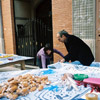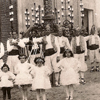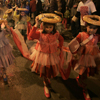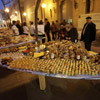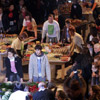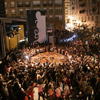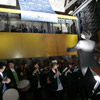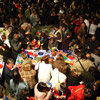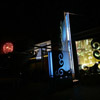Edible Tongues
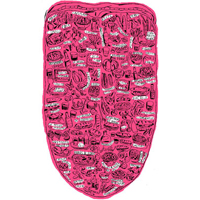 |
The Pilgrim Gaiata & The Edible Tongue of Castellón
In 2006 Alicia Ríos and Antoni Miralda were invited by EACC (Espai d'Art Contemporani de Castelló) to give a series of workshops that examined the local fiestas of the Magdalena held every March. They both have considerable experience creating community performances which draw on local referents, symbolism and myth within a wider understanding of the universal elements of public ritual celebration such as music, dance, food, costume, procession, offering, sacrifice and catharsis.
In the case of the fiestas of the Magdalena the principal icon is the gaiata, an elaborate temporary festival structure that integrates references to all the fiesta's other symbolic elements. Called Monument de llum i color sense fum ni foc (monument of light and colour without fire or smoke), they are three-dimensional geometric forms incorporating countless lights of different colours that illuminate them from within and without. During the fiestas, the gaiatas are paraded through the city at night recalling the city's foundational story of the voyage of its original inhabitants from the hills to the plains as well as themes of pilgrimage and religious illumination.
The three workshops were dedicated to the concepts of monument, light and gastronomy. These categories formed the basis by which to consider all the different elements of the fiestas, analyse their symbolism and discuss ways in which they could be reconfigured and re-presented to the public in an innovative, contemporary gaiata, renewing the connection between the city and its traditions.
In March 2007, under Alicia and Miralda's direction, the workshop attendants participated in the fiestas through their creation of The Pilgrim Gaiata and The Edible Tongue of Castellón.
The Pilgrim Gaiata was a structure of three panels of 8, 4 and 2 metres in height, decorated with the abstracted outlines of a traditional gaiata profile. Lit from within, they changed colour while also displaying a series of projected images that reflected the symbolism of the fiestas.
The Edible Tongue of Castellón consisted of 14 tables that fit together to make a tongue of 30 square metres, laden with ingredients and dishes that reflected the development of the local cuisine since prehistoric times, progressing from the oldest traditions at the back to the latest innovations at the tip. It was inspired by Miralda's Sabores y Lenguas (Flavours and Tongues) series in which he maps the gastronomic culture of cities all over the world onto the image of a tongue.
For the event, a spectacular long white limousine was paraded through the city, lead by the traditional xiquetes del meneo and followed by musicians, to the EACC, where the Pilgrim Gaiata had been installed. Then, the Edible Tongue was wheeled out and assembled before the crowds and hundreds of people proceeded to devour the culinary heritage of the city, mapped out on its taste buds.
Afterwards, the Pilgrim Gaiata travelled to Valencia to be installed in the esplanade of MUVIM (Museu Valencià de la Il-lustració i de la Modernitat) and later in the Castellón neighbourhoods of Donoso Cortés and Grupo Reyes before returning to EACC.
In addition, the workshop participants produced a commemorative newspaper/manifesto for the occasion called The Gaiata Peregrina in order to present all the research and thought that went into the project.
The Pilgrim Gaiata and the Edible Tongue of Castellón were created under the direction of Antoni Miralda and Alicia Ríos by:
Rafa Belda, Lourdes Chesa, Emilio Ibáñez, Ilaria Maura, Natalia Muñoz, Ana D. Prades, Gema del Rey Jordá y Mónica del Rey Jordá
Press
A bocados con la 'gaiata' del Espai d’Art(download pdf)
Nuria Balaguer, Las Provincias, 15/3/2007
|

